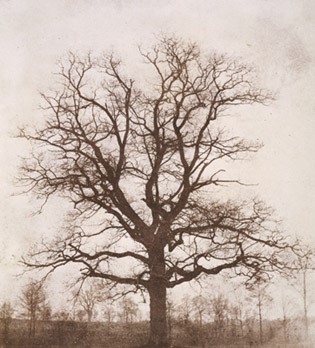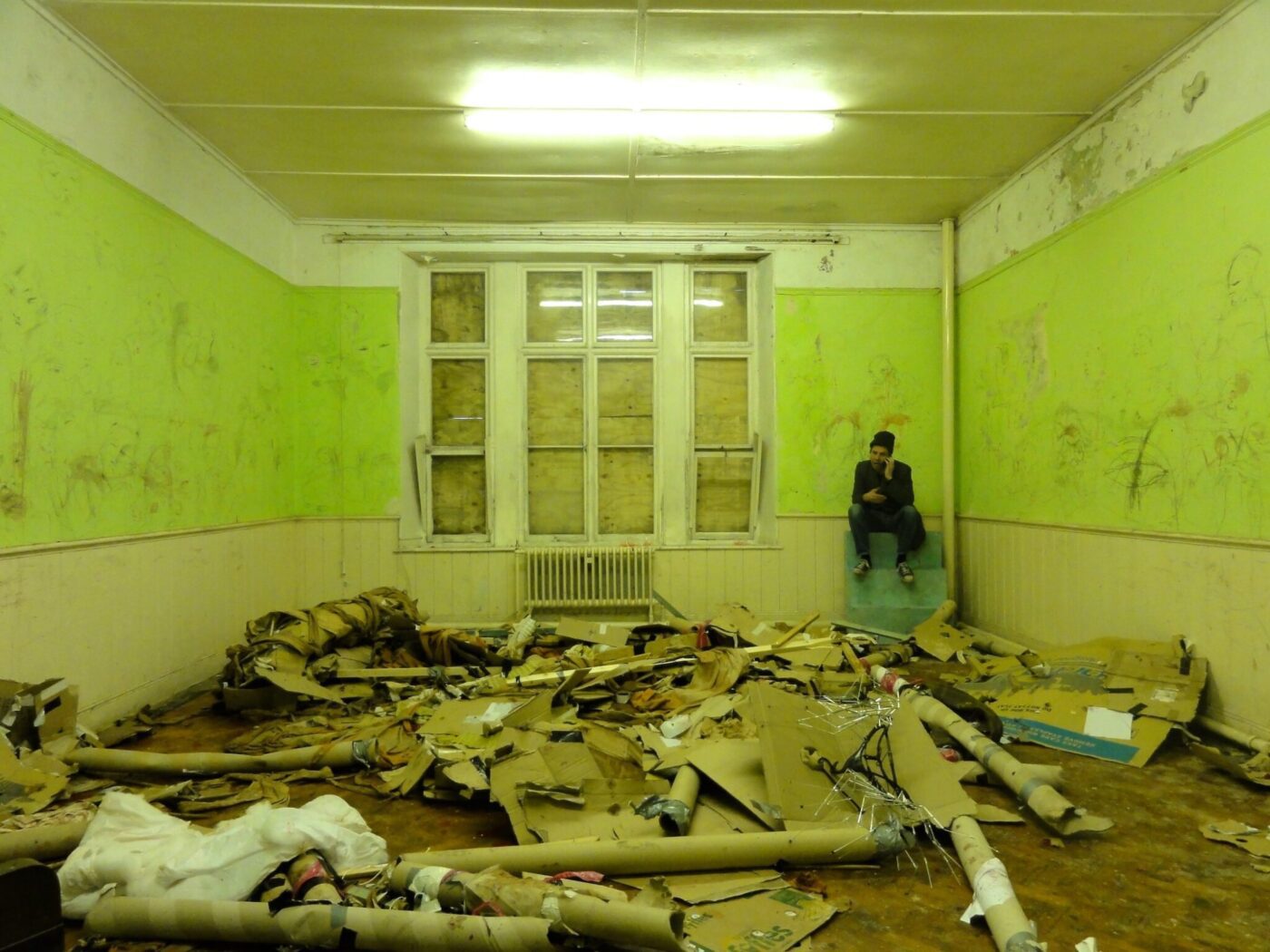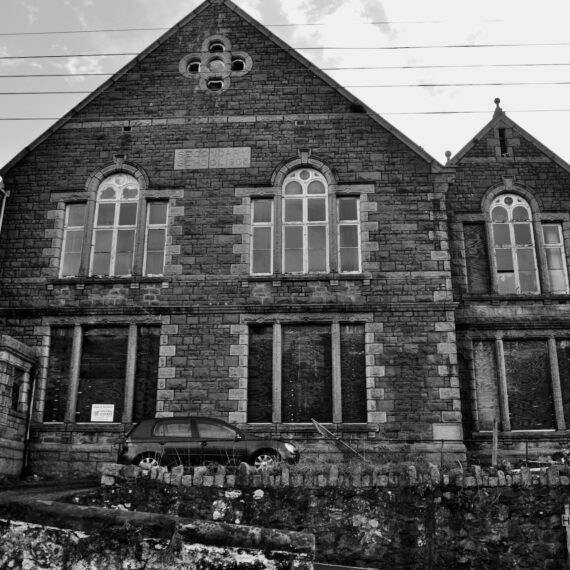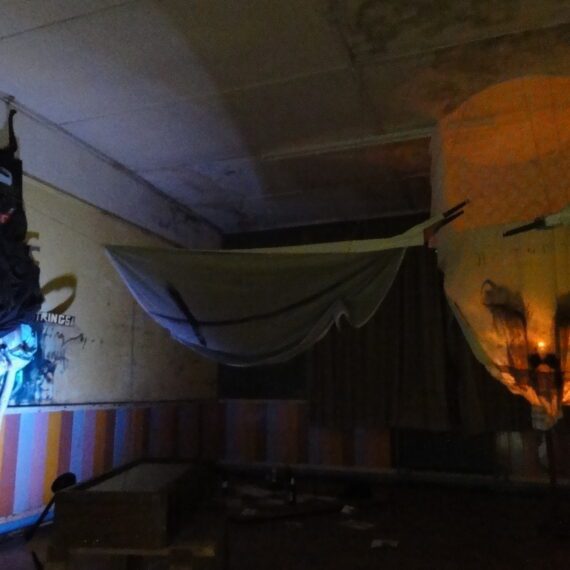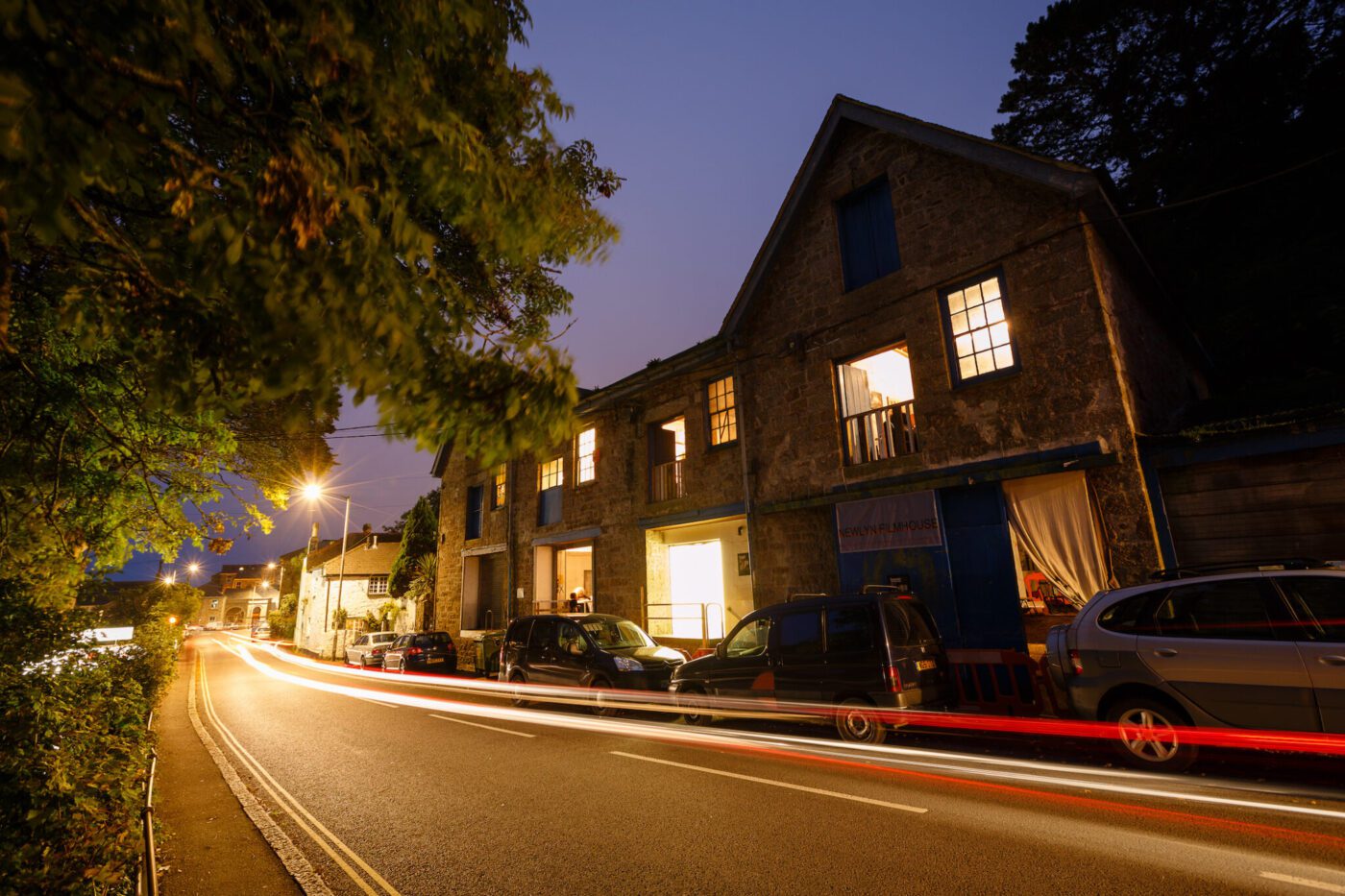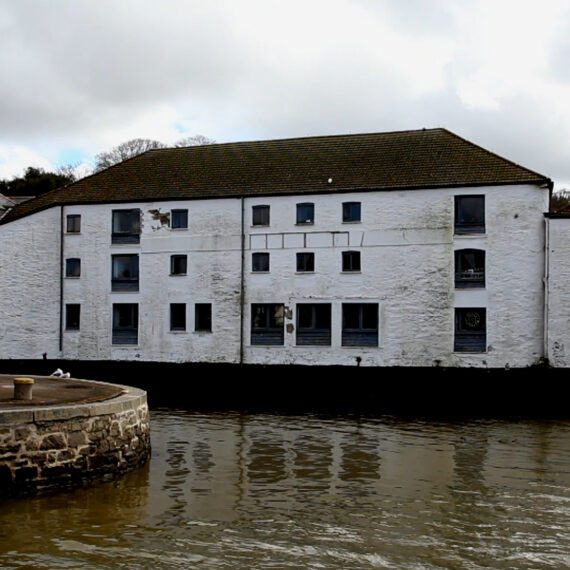Text: The Dark Rooms – Eliot Alison
The Dark Rooms
Passmore Edwards Building, Helston, Cornwall
1st/2nd Feb 2013
Eliot Allison
‘The Dark Rooms’ could not be a more evocative title, summoning images of dank and repressive spaces, and certainly not places that one would consider at the epicenter of a professional exhibition of Cornish art. Jesse Leroy-Smith, a proud figure amongst the artistic circles in Cornwall, curated this exhibition at the Passmore Edwards building in Helston during the space’s transformation from dereliction to dedicated art space. It certainly was something special.
Opened in the late 1800’s, the Passmore Edwards building served first as a School of Arts and Science, then as a secondary school, before becoming the local community centre. Since 2009 however, the building has stood dejected and derelict, wasting away in the town. This memory is long gone however, with ‘The Dark Rooms’ being the catalyst in this.
In 2012 the building was bought for the charity CAST, recognizing the structure’s potential, and hoping to restore it as a centre of artistic balance between Falmouth, Truro and the Penwith peninsula. Leroy-Smith approached the CAST trustees with the idea of doing a project in the building in its present semi-derelict state, and offered to provide an exhibition that could illustrate the innovation and exciting work artists are producing in and around Cornwall, whilst also providing a cacophonous, dark experience that would allow the viewer to intimately relate to the exhibition as a collective work, not just celebrate individual artworks. I was asked by Jesse Leroy-Smith to aid the creative and technical process within the exhibition, an opportunity that I jumped at enthusiastically.
My first encounter with the space occurred on the first of February. I was greeted with a cold, dilapidated demeanor. Each corridor wove its way into various rooms filled with a myriad of sculptures, paintings and soundscapes, all of which reacted and worked within the framework of the space.
The first work in progress that I encountered was by Sam Bassett (St Ives born and an instrumental part of the Newlyn School of Art and Bucca gallery), a monumental installation (see Plate 1) of ethereal, sail-like sheets supporting a projection. The piece exemplified many ties with his local heritage imbued in the nautical themes, whilst also, through his use of projection, reacting with the room in quite a surreal way. Ones eye cast through these ghostly structures to attempt to focus on the wrestling figures in the film, however their ambiguity removed them from perception, highlighting the emphasis of darkness: no one can see each other.
Next I moved onto Jesse’s space – a bright green room with one central structure, a 2x2x2 meter clay/mud and cardboard head, scrutinizing me as I walked into the room. Jesse explained that it was to be part of a performance piece that would occur the following evening. The lime-green walls were empty yet vibrant, which initially detracted emphasis from the solid structure in the centre of the room. My initial instruction was then given: ‘take a selection of my drawings and, using this graphite pencil, cover them in forms’. Over the process of the day and following one, these walls became alive with human figures in a multitude of styles from different individuals, all adding to the ominous stare that the head transfigured. As the room progressed, it became more coherent, but also more frenetic. The cacophonous feeling had begun, the energy was building and building and building … and I could not wait for the climax.
I spent my day hanging various artists’ work in a variety of spaces, whilst nosily intruding on other peoples’ work, catching a developmental perspective on their ‘Dark Rooms’ pieces. One artist that I spent a good deal of time with was Faye Dobinson, a London-born artist currently residing in Perranuthnoe, Cornwall. Her piece was presented in a very small space, which I helped to light seal. The industrial door provided a portal-like feel to the room, as if one was leaving in a rocket into the blackness of space. Her film piece, presented on a large television monitor, documented a sporadic leaf, passing through air like ink in water, moving any which direction the wind took it. After having adjusted some technical difficulties regarding wiring and electrics, we stood back and were mesmerized: the lifeless had become full of life.
Faye went on to explain that the leaf had significant and maudlin undertones in reference to a close friend who had most shockingly taken his own life. She had seen ‘The Dark Rooms’ as a perfect opportunity to reflect on his peace of mind and his happiness within the quiet of death. This, for me, of course induced a completely new perspective on the work. The spectacle, the subject, now had such strong meaning.
She had also, when attending the funeral, become very fond of a piece of drum ‘n’ bass music that epitomized her friend’s rambunctious attitude. After installing the speaker myself, and syncing the urban anthem with this rural observation, Faye and Jesse and I stood back to look upon the work in its entirety. All of a sudden the leaf had intention, it wasn’t so much an ambling reminder of the unpredictability of life, instead, as Faye so aptly put, it was having ‘a fucking good time’. The sorrow that this solitary leaf exuded for me now had undertones of euphoric happiness and movement.
The next day brought me a slew of new challenges and observations that were both exciting and frustrating. A friend of Jesse’s, a graduate of the Royal College of Art currently lecturing at Kingston University, Matt Benington arrived with a range of works to set up and hang. I met Matt in the van travelling up to the space. The conversation began relatively mundanely:
‘alright mate’
‘alright brother. Matt, pleasure to meet you’
‘Eliot, you too.’
-pause-
‘so are you an artist?’
‘yeah man …
Our discussion flowed into ‘The Dark Rooms’ and how exciting the project was. This conversational river then, unexpectedly, opened out into the estuary of art and before long we were in turn discussing the impact of social media on art, the biggest questions that we feel have been provoked recently within art, Gerhard Richter, the London art scene etc. This talkability and connection solidified us as a collaborative force for the next thirteen hours of the day.
Matt’s first piece was a photograph taken in the same place as Fox Talbot’s famous tree exposure (See Plate 2). On the right hand side a digital insertion depicted the gradual burning of the tree, its degradation as a significant artifact in history. This degradation reflected well on the space and worked within the environment. It also provided fantastic contrast to the many moving image works that occupied most of the spaces.
The static, black and white image sucked one into the eyes of the photographer and the motion was hidden in the corners of each work. A speeding National Express coach, like a placid white sore thumb, is visible on the left hand side, enforcing the theme of movement from a place to another within the work. As Matt joked, ‘it’s burning through the heritage’: bold but true. His work seemed to be expressing a comfort and underlying, almost punk, attitude to the past, however not disrespecting it, allowing room for change. The work screamed, pretty ‘un’ vacantly, that time has moved on – just like the Passmore Edwards building. I found the photograph quite shocking in many ways; the idea of icons burning is in itself a very interesting concept.
We then moved on to installing one of Matt’s films, filmed at the same Fox Talbot estate near Bath. This performance/film piece depicted another Fox Talbot print, seen through the arch in which it was taken. After a few moments, the image began to burn from the bottom, opening like a flower to sunlight, bringing history into the new world. The town below ate away at the image and thus the scene was transformed. This transformation was very spectacular, allowing us to shift through time carried by fire. Some seemed to interpret the burning as a disrespectful gesture and not one significant of change. I think that this conceptual ambiguity however adds to the feeling of progression; we have moved out of the solid and into the new. Matt’s work really sat well in the experience Jesse was creating in this transitional period.
For me, the most spectacular support to this whole experience however was the sun and the moon: darkness. As the exhibition opened at 5pm, the hum of twilight was on the horizon. The shadows in each room began to grow and gradually drown the building in a swathe of darkness, a darkness that we were all swallowed by. Each piece began to stand out even more, distinct against its void-like backdrop. The cacophony had begun.
I was to be working on the bar that evening, allowing me to engage with many guests, which was fantastic for me. The beautiful thing about all of this interaction was that it was produced and cultivated entirely within darkness. I made many acquaintances that night that I have no idea what their faces look like, instead know how they speak. The experience changed the way people interacted. It totally contrasted with the high-line white walled openings we’re all used to, instead it plunged the same experience into dereliction and darkness.
The final piece of the night was Jesse’s ‘head’. Having not worked in the room for a couple of days, I was astounded by the magnitude of the forms and faces on the walls, supported by this central figure. The head had been fitted with torches that shone from each orifice, representing a medusa of the light or a vibrant and luminous dandelion clock. Jesse entered the head and began the process of pushing it into the walls, each knock removing parts of the head bit by bit. Watching this form fall to pieces upon the floor, coating the room in the debris of form was quite shocking. This was then emphasized by the emerging Jesse tearing at the parts of the cardboard form like a rabid dog, every milli-molecule of repressed stress released smashing up this face. The room was left in a papier-collé state of flux; there was no direction anymore. Jesse emerged a sweating and relieved man and threw his arms around all of us in the audience. He had succeeded.
Walking around the room after the piece, the miscellaneous cardboard, mud, blood, sweat and jelly (?) stood as a reminder of this repressed emotion, this internal feeling that had been released (See Plate 3). The degradation had happened, it was now time for the space to take up its throne as the figurehead of the arts in Helston. The building was swallowed in silence again, as each artist and assistant looked through the spaces individually, absorbed by the void, the space that we had all created. ‘The Dark Rooms’ was the catalyst, the bulldozer that instigated this space. May it remain and serve artists for years to come.

